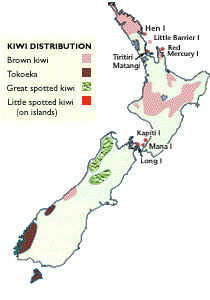
Map
of Kiwi Distribution:
Brown Kiwi: Pink
Tokoeka: Brown
Great Spotted Kiwi: Green
Little Spotted Kiwi: Red

Preface:
Found only in New Zealand, the nocturnal Kiwi bird is a very interesting and unusual avian and the only living example of the family Apterygidae. The number of subspecies was revised in 1993 and currently the reigning scientific community classifies four species and two sub-species of Kiwi, forming six distinct varieties in all: the Great Spotted Kiwi (Apteryx haatii), the Little Spotted Kiwi (A. oweni), the common or Brown Kiwi (A. mantelli), present in two varieties – the North Island Brown Kiwi and the Okarito Brown Kiwi, and the fourth sub-species, often left unmentioned due to the absence of “kiwi” in their name, the two varieties of the Tokoeka – the Haast Tokoeka, the rarest of the kiwis, and the Southern Tokoeka, which grow to be almost as big as the Great Spotted Kiwi. Fossil records indicate that kiwis evolved around 70-30 million years ago, and fossils from the Pleistocene era show evidence of two more, extinct, varieties. Relatives of the emu and ostrich, it is believed that their closest relative is the now-extinct New Zealand moa, a 11-foot-tall flightless bird hunted to extinction approximately 200 years ago; the ancestors of the kiwi most likely flew to New Zealand from Australia before becoming flightless. The kiwi is a ratite bird – that is, a flightless bird of the same lineage as the emu and ostrich. Nocturnal, they dwell in burrows on the forest floor and are generally a dullish gray or brown color. It spends most of its day sleeping, running and hiding if threatened.
Characteristics:
Kiwis are approximately 14-22 inches in length, and range in height from 15 inches (Little Spotted Kiwi) to 20 inches (Great Spotted Kiwi), and weigh in at approximately 5 pounds. Females are larger than males and have a longer beak, but the sexes share the same drab plumage. Though coloration varies a bit across subspecies of kiwi, they are generally a brownish-gray. Their wings are tiny remnants hidden beneath a coat of hairy feathers and usually only visible on newly-hatched chicks. They lack a tail, giving them a rounded appearance. Their legs are short but powerful, making up approximately 2/3 the kiwi’s weight; the feet are similar, and are tipped with claws. Their beaks are approximately 6 inches long and thin, curving downward, with nostrils at the tip; long, hair-like feathers grow from the base of the bill and function somewhat like whiskers. They lay the largest egg in proportion to size of any bird and are the only known birds in which both left and right ovaries are present and functional. All males of the species share a shrill, mournful ki-wi call, though varied in pitch in intervals; females possess a hoarser cry. North Island Brown Kiwis are dark grayish brown with reddish-black streaks stemming from 3-colored feathers; Okarito Brown Kiwis are more grayish, with white facial feathers; Little Spotted Kiwis are mottled brownish black and gray with a gray head; Greater Spotted Kiwis are larger than Little Spotted Kiwis and have a strong chestnut-brown colored back. Kiwis in the wild can live to approximately 20 years of age, and those in captivity can live up to 40 years. Due to their rather low body temperature (more in the mammalian range rather than avian) and their many mammal-like attributes, kiwis are affectionatively referred to as “honorary mammals” in New Zealand.
Range:
Kiwis are found only on the island nation New Zealand, which is made up of the North Island, South Island, and Stewart Island. While two centuries earlier they ranged across both the mainland and the nearby islands, this century’s colonization and development of New Zealand have greatly reduced their range on the mainland to the point where some species, such as the Little Spotted Kiwi, have been driven to extinction on the mainland and exist only on the neighboring islands. The North Island Brown Kiwi now lives only along the upper two-thirds of North Island, widespread through Northland. The Okarito Brown Kiwi was discovered in 1993 north of Franz Josef and today lives in the forests of Westland National Park (New Zealand’s West Coast). The Great Spotted Kiwi now lives in rough territory at high altitudes along northwest Nelson, the northern West Coast, and between Arthur’s Pass and Lake Sumner in the Southern Alps. The Little Spotted Kiwi is now extinct on the mainland and exists only on the predator-free bird sanctuary of Kapiti Island. The Haast Tokoeka live in southwest New Zealand (in Westland) across a broad range of altitudes (from sea level to mountains), while the Southern Tokoeka live in Fiordland and on the relatively-untouched Stewart Island.
Adaptations to Habitat:
Kiwi live primarily in New Zealand’s remaining dense forests, but are also found in pine forests, sub-alpine tussock, scrubland, and rough farmland; on South Island kiwis are also found on sub-artic lands periodically covered in snow. They can also sometimes be found hunting sandbugs along the seashore. Haast Tokoeka kiwi often spend a great deal of the year in grasslands around the Alps, some staying year-round, others wintering in lowland forests. Great Spotted Kiwi spend most of their lives in the mountains of the Alps. As more and more of their lowland forest is developed into farmland, kiwis are extending their foraging areas to the open grassy areas of these farms.
As primary forest-dwelling ground birds, kiwis have are well-adapted to their environment. Their barbule-less, hairy feathers insulate them against the cold and damp, allowing them to forage even on the coldest nights and protecting them from any dampness that may penetrate their burrows. Their thick coat also protects them against injuries such as scratches as they crash through the underbrush, and their dull coats give them excellent camouflage as they hide in burrows or under logs during the day. Their powerful legs carry them surely through the brush as well as the bush, and aid them in excavating their burrows. They are also the key to a kiwi’s defense: when its nest is threatened, a kiwi will rush its attacker, kicking and clawing with poison-tipped toes, before retreating into the bushes. Hardy birds, kiwis can climb steep, rugged slopes; they can also swim across rivers, a feat observed in several radio-tagged kiwis.
Kiwis are unique when it comes to sensory perception. Their eyesight – usually the most highly-developed sense in birds -- is very poor. Their eyes are small for birds of their size and they have an unusual retina placement, resulting in far-sightedness in most kiwis. Scientists have placed the range of the kiwi’s sight at a distance no further than eighteen feet at night and only two during the day. The kiwi has whisker-like hairs at the base of its beak that scientists believe are touch-sensitive, like a cat’s, and help guide the kiwi through the darkness. However, as nocturnal hunters, kiwis do not rely on sight to locate their food. The kiwi’s sense of smell is very highly developed – so much so that scientists estimate it is as good as many mammals’. With its nostril placement and large nasal cavities and facilities, it is believed that the kiwi is able to orient itself by smell. The kiwi is also the only bird to have its nostrils at the end, or tip, of its beak rather than at the base, and it is believed that this placement, when coupled with the kiwi’s strong sense of smell, allows the kiwi to sniff out its food.
Diet:
In the wild, a kiwi’s diet consists mainly of earthworms, ground insects, their larvae, and other invertebrates, as well as fruits, seeds, and other plant material strewn along the forest floor. Kiwis emerge to hunt at night, using their exceptional sense of smell to guide them to above-ground food and prey – scientists report that hunting kiwis “snuffle” through the forest as loudly and as well as any mammal – as well as that below-ground. Kiwis use their long beak to probe the earth for invertebrates, plunging its full length into the soil and using their beak tip nostrils to sniff out burrowing larvae or earthworms. They rarely drink water but are known to eat aquatic insects when their habitat range includes bodies of water. Kiwis, especially the North Island Brown Kiwi, are significant predators of crop-eating pests such as the scarabaeid beetle; however their diet varies with availability of food, and they are known to take cultivated vegetables (peas, cabbage, etc) when necessary. In captivity, it is difficult to obtain sufficient amounts of invertebrates to sustain the kiwis, and so along with berries and other plant products scientists feed them a variety of milk-powder and vegetable oil mixes, with mixed success.
Competitors / Predators:
As they eat mainly ground pests and fallen fruit, kiwis have few competitors except themselves. However, as kiwi populations have fallen so low this past century, the varieties of kiwi have become more and more separated from each other and are thus competing very little if at all. Rats and Japanese deer are also a problem for the kiwis.
Kiwis have no natural predators.
However, as they evolved in an environment devoid of mammals, the colonization
of man and introduction of domesticated animals has brought the kiwi numerous
predators. Today it is preyed upon by stoats and weasels (mustelids),
ferrets, rats, pigs, cats, dogs, and Australian possums. (Little
Spotted Kiwi, however, somehow co-exist with the possums on otherwise predator-free
Kapiti Island.) The stoats, weasels, and opossums were brought to
New Zealand to establish a fur trade; the pigs, for farms; many of the
rest are either pets of early settlers that have turned feral or pets of
present-day owners that either turned them loose or let them run untethered.
The mustelids prey mainly on the kiwis’ eggs; stoats and cats are responsible
for most juvenile kiwi deaths. Older kiwi are able to defend themselves
against stoats and cats but remain vulnerable to dogs and ferrets; young
kiwi cannot defend against any of their predators.
Behavior and Life History:
For the most part, kiwis are reclusive, shy birds. Though territorial, most species, most notably the Little Spotted Kiwi, are docile (the Little Spotted Kiwi is even described as being “mellow”), although several sources state that the Brown Kiwi possesses a rather short temper. Although scientists observing kiwi wear no protective gear and often do not even use a hide, their subjects do not usually show any indication of interest or anxiety. A notable exception is during breeding season (July-February). During this time, males will attack anything, including humans, that ventures too close to their underground nest, kicking and scratching at the intruder with poison-tipped toes before retreating. Females, interestingly, do not adopt this pattern of behavior. Kiwis are known to adopt a rather interesting stance when resting – forming a tripod by resting with its beak to the ground.
Reclusive birds, kiwis usually hunt alone at night, roosting in marshes or vegetation in forests. During their nighttime hunt in forests or seral vegetation, the males also participate in calling. The Southern Tokoeka, the most communal of the varieties, is sometimes spotted in small groups. Male kiwis establish their territory at 2-5 years of age, females at 3-5 years of age; however, they do not usually breed until they are 5-6 years old, as kiwis reportedly grow at a slowly.
Kiwis are monogamous and mate for life. The nest is usually constructed by the male, with some help from the female, close to hunting areas of vegetation (so the young do not have far to go to forage), and is lined with feathers. The female typically lays a single egg in an underground, or otherwise covered, nest; the egg is incubated for up to 11 weeks (75-80 days – the second-longest incubation period in modern birds) by the male, who stays with the egg (does not leave to forage) for as long as a week at a time until it hatches. This arrangement, with the male incubating the egg, is very unusual and rarely seen in birds. It is thought that kiwi do this so that the female may rebuild her reserves and recuperate – the kiwi’s egg is the largest egg in proportion to body size of any bird, and typically makes up 20-25% the female’s body weight – especially since, if the egg does not hatch, she may have to lay another one (a female kiwi can lay as many as 5 eggs in a season). Once the chick hatches from the 5.5 * 3.5 inch, 1-pound egg, the male will once again leave the nest at night to forage. The chick is thus abandoned at night for the first 3-5 days of its existence, until it ventures out of the nest and is aided my the male in feeding. That the chick must live without food for the first few days of its life is most likely why kiwis have the largest yolk sac (and thus energy content) of all birds. Kiwi chicks are precocial – born with feathers and able to move about after a few hours after hatching – but instead of having the fluffy down common to most precocial birds, they are born with brown feathers similar in every way to the parents’, only of a richer hue.
Status:
Kiwis are listed as endangered species. Numbering in the millions a century ago, kiwi populations have been decimated by the introduction of foreign predators. While the island populations of Stewart and Little Spotted Kiwi remain stable, free from mammals and even showing some increase, populations on the mainland are declining at a rate of 5.8% a year due to introduced mammalian predators. In 1987, no less than 500 kiwis were killed from August to September because a freed German Shepard had been roaming the woods. 50% of kiwi eggs fail to hatch; of those that do, only 5% survive their first year. 95% of kiwi chicks are killed within 6 months of hatching. Not all of these deaths are due to predators, however – many come from forest clearing or burning / crushing their burrows as ground is leveled for development; the birds are also run over by cars, caught in possum traps, or poisoned by cyanide. It is believed that the kiwi will become extinct in 16-20 years if the current rate of decline is not stopped.
The government of New Zealand is taking steps to protect its national bird. It is now illegal to kill or even own a kiwi. Pet owners – especially dog owners – are asked to keep their dogs leashed when on walks and impound any dog found wandering on their property; unwanted pets are to be sent to SPCA animal shelters, not released to run wild. Hunting (especially pig hunting) with dogs in kiwi areas is advised against, and hunters are asked to train their dogs not to pursue kiwis. Possum trappers are asked to use “kiwi-safe” traps and are required to put traps off the ground in a place where kiwis cannot get caught in them. Farmers are instructed to fence livestock out of forested areas and consider other methods of protecting forest / scrubland and to keep dogs under control day and night. Foresters are asked to plant forests in varied-age compartments so kiwis can find new homes when the trees are harvested; they are also asked to leave at least two months between logging and burning a plot to encourage kiwis to move.
Many independent agencies
are sponsoring projects aimed at restoring the kiwi population. Landowners
and communities are “adopting” forested areas and the kiwi that live in
them, modeling their actions after that of another groups, the Kuaotunu
Kiwi Sanctuary, a collection of forests and farms that work to control
predators. The iwi, Maori tribal groups, are also protecting their
kiwi – pig hunting is prohibited in some areas, and people are urged to
control their dogs. A large project aimed at saving the kiwis, sponsored
by the Bank of New Zealand, is the Kiwi Recovery Programme. One part
of this programme, Operation Nest Egg, involves taking kiwi eggs from the
wild and hatching them in captivity. Much like the technique used
on endangered condors in the United States, kiwi chicks are then raised
for 6-10 months, until they are able to survive in the wild, before being
radio-tagged and released into the wild or into predator-free sites.
This project, based on research that suggests the 5.8% a year decline could
be halted if the mortality rates of young kiwi fell 34-33%, has increased
the chicks’ survival rates to 85%, and is also helping increase the reproduction
rate of kiwis, as females will lay more eggs if their first is lost.
At present the Department of Conservation, along with the Royal Forest
and Bird Protection Society, are also sponsoring the Kiwi Recovery Programme,
and the New Zealand government has also pledged at least $3 million to
the programme. Many island sanctuaries free of predators, similar
to the one on Stewart Island, are currently under development.
The chart below shows the estimated amounts of kiwis in 1996 and the
projected amount of kiwis in 2006 if Operation Nest Egg and the other efforts
of the New Zealanders and the Kiwi Recovery Programme continue at their
current rates. The table illustrates just how much more efforts will
be needed to right the situation, as only the Little Spotted Kiwis, safe
on their island sanctuary, show an increase in population. New Zealanders
are proud of their unique national symbol and are determined to protect
it from the peril their forefathers have placed it in. Scientists
indicate that the results of the programs so far are promising, but for
any real chance of success, more resources (funding, manpower, etc) will
be needed to decrease the mortality rate of the young kiwi and stymie the
influx of unnatural predators.
| Sub-species | Population in 1996 | Projected Population for 2006 |
| North Island Brown Kiwi | 35,000 | 20,000 |
| Okarito Brown Kiwi | 125 | 75 |
| Haast Tokoeka | 225 | 125 |
| Southern Tokoeka | 27,000 | 24,000 |
| Great Spotted Kiwi | 22,000 | 12,000 |
| Little Spotted Kiwi | 1,100 | 1,200 |
| Approximate numbers of all kiwi | 85,000 | 60,000 |
 | Map
of Kiwi Distribution:
|
Pictoral Illustration of the Six Currently Recognized Kiwi Varieties:
 North Island Brown Kiwi - Apteryx australis mantelli
North Island Brown Kiwi - Apteryx australis mantelli
 Okarito Brown Kiwi - Apteryx australis mantelli
Okarito Brown Kiwi - Apteryx australis mantelli
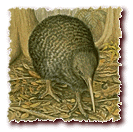 Great Spotted Kiwi - Apteryx haastii
Great Spotted Kiwi - Apteryx haastii
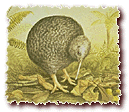 Little Spotted Kiwi - Apteryx owenii
Little Spotted Kiwi - Apteryx owenii
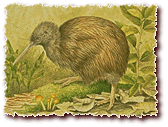 Haast Tokoeka - Apteryx australis
Haast Tokoeka - Apteryx australis
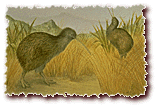 Southern Tokoeka - Apteryx australis lawryi
Southern Tokoeka - Apteryx australis lawryi
Bibliography:
Baker, AJ, et al. Flightless Brown Kiwis of New Zealand Possess
Extremely Subdivided
Population Structure and Cryptic Species like
Small Mammals. Proceedings of
the National Academy of Sciences, USA. 1995.
92:18, pp. 8254-8258.
Colbourne, R. Little Spotted Kiwi Recruitment on Kapiti Island:
A Response to J.N.
Jolly. Journal of the Royal Society
of New Zealand, 1994. 24:2, pp. 169-170.
Czeika, S; Taborsky, B; Taborsky, M. Food Distribution and
Habitat Selectivity
in Brown Kiwi Apteryx australis. XXI
International Ornithological Congress,
Vienna, Austria, 21-27 Aug 1994.
Falla, RA, Sibson, & Turbott. The New Guide to the Birds
of New Zealand.
Monoset Trade Services Limited, Auckland, New Zealand.
1983.
Howland HC; Howland M; Schmid KL. Focusing and Accommodation in the
Brown
Kiwi (Apteryx australis). Journal of Comparative
Physiology, 1992. 170 (6):687-9.
Kiwi faces extinction in wild, says society. The Evening
Post. Wellington, New Zealand,
09-13-1999, pp 14.
McLennan, JA, et al. Role of Predation in the Decline of Kiwi,
Apteryx spp., in New
Zealand. New Zealand Journal of
Ecology, 1996. 20:1, pp 27-35.
Montgomery, Sy. New Zealand’s Kiwi Proves Astonishing, but
its Future is Grim. Los
Angeles Times, 1989, May 1.
Perrins, Dr. Christopher, and Dr. C.J.O. Harrison. Birds: Their
Life, Their Ways, Their
World. Reader’s Digest Association, Inc., Pleasantville, NY,
1979.
Pettingill, Olin Sewall, Jr. Ornithology in Laboratory and
Field, Fourth Edition. Burgess
Publishing Company, Minneapolis, Minnesota, 1970.
Pratt, Mike. “The Kiwi Recovery Programme Web Site.”
The Bank of New Zealand.
1999.
http://www.kiwirecovery.org.nz/
Potter, MA, and Cockrem JF. Plasma Levels of Sex Steroids in
the North Island Brown
kiwi (Apteryx australis mantelli) in Relation
to Time of Year and Stages of
Breeding. Gen. Comp. Endocrinol.
1992. 87 (3):416-24.
Taborsky, B. Significance of Environmental Variables for Kiwi Spacing.
XXI
International Ornithological Congress, Vienna, Austria,
21-27 Aug 1994.
Taborsky, B; Taborsky, M. Habitat Use and Selectivity by the
Brown Kiwi (Apteryx
australis mantelli) in a Patchy Environment.
Auk, 1995. 112:3. pp. 680 – 689.
Taborsky, B; Taborsky, M. The Mating System and Stability of
Pairs of Kiwi Apteryx
spp. Journal of Avian Biology,
1999. 30:2. pp. 143 – 151.
Taborsky, M. Reproductive Energetics of Brown Kiwi.
XXI International Ornithological
Congress, Vienna, Austria, 21-27 Aug 1994.
Wenzel, BM. Olfactory Prowess of the Kiwi. Nature, 1968. 220 (172):1133-4.
Wenzel, BM. Olfactory Sensation in the Kiwi and Other Birds.
Ann NY Academy of
Science, 1971. 188:183-93.